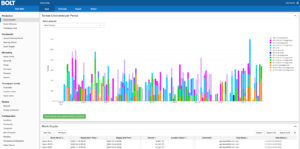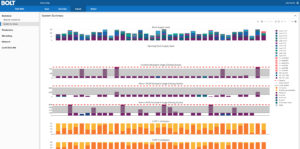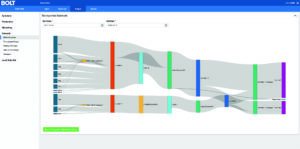
The engineers above, using BOLT, can see how production decisions can affect business outcome throughout the supply chain, by modeling multiple what-if scenarios.
Breaking down silos and automating decision processes allow miners to make more informed choices about stockpiling, blending and marketing
by steve fiscor, editor-in-chief
When it comes to producing and exporting bulk commodities, such as thermal and met coal, the material is often stockpiled several times before it reaches the customer. Raw materials are stockpiled before the processing plant. Processed materials are stockpiled after the plant and before it is loaded for transport. Sometimes raw product is allowed to bypass the plant. The material is typically stockpiled again at a port facility before it’s loaded on to a ship.
Many of the variables along this supply chain can impact the possible outcome adding complexity to the planning process. For example, the information about geology in the pit could change. Processing plant settings affect product quality and yield. Blending presents further opportunities and challenges. Poor performance can erode profit margins leading to costly contractual penalties or excessive demurrage charges as a ship waits to load.

A BOLT visualization showing the mining schedule by source.
Polymathian, a group of Brisbane, Australia-based software developers and industrial mathematicians, have recently solved some complex logistics puzzles for mining companies. They recently shared a case study that showed how their BOLT platform not only provided an immediate financial return, but also gave the mining operation a new perspective in planning and marketing. Ultimately, they were able to help miners devise an optimal pit-to-port plan.
BOLT is a cloud-based supply-chain optimization support tool that automates, optimizes and centralizes the planning process. The system generates optimal planning solutions in minutes. Multiple planners can produce plans in parallel using the same information. The system has allowed mining companies to better align supply with demand to increase profitability. It also makes it possible to rapidly respond to unplanned disruptions. Because the results are available in minutes, planners can run multiple “what-if” scenarios to ensure mine operations continue
as efficiently as possible.

A BOLT visualization of the optimal plan for material movement and storage between the mine and the port.
Carrying Coal to Newcastle
An Australian thermal coal mine with a wash plant transports its product 130 kilometers (km) from the Hunter Valley to ports in Newcastle, New South Wales. Prior to Polymathian’s arrival, the engineers at the mine produced strategic plans that covered development, production and marketing tasks. These planning processes needed to be improved to better manage the entire supply chain and maximize profit.
The mine was exporting about 11 million metric tons per year (mtpy). That equates to about 115 trains a month cycling between the port and the mine. Multiple customers wanted to purchase coal and each had certain quality specifications. Millions of variables needed to be simultaneously solved for across the supply chain and that’s an area where Polymathian thrives.
The mine was using manual planning processes that were time-consuming and error prone. Each stage had silos of valuable information, which were not easily accessed, and slowed the operation’s ability to respond to change.
After implementing the BOLT platform, the mining company realized a tenfold reduction in the level of effort required for the planning process, according to Polymathian. They also achieved a 10% improvement in profit margins and they now have guaranteed pit-to-port planning optimality.
“Initially, we were given a production schedule,” said Jonathon White, director and Polymathian co-founder. “We knew the quality associated with each coal block coming out of the mine for the next two years. We also had information about what will happen if the coal was washed in different ways. We determined how the product would flow through this complex network. In this case, we were really making decisions regarding stock-piling. Should the coal go to the run-of-mine (RoM) stockpile or the crusher? If it reports to the RoM stockpile, how long should it stay there? Once it passed the crusher, what type of processing should be used? How should the processing plant operate?”
In some cases, the coal could bypass the processing plant, White explained. “Bypassing the plant would provide a yield gain, but a quality loss,” White said. “What specific gravity set points should be used? … 1.3, 1.4 or 1.5? Dual- or single-stream wash? Those decisions were followed by more clean coal stockpiling decisions. Which trains should pick up the coal and when?”
The mine could export through either of two ports and there were additional post-port questions related to marketing. What would be the best blend that would meet specs, minimize exposure penalties and maximize potential for bonuses within specific contracts? For uncommitted coal, six months away, should the product become a semisoft coking coal or a low-quality thermal coal.
The tenfold reduction in planning effort was the direct result of the engineer’s ability to develop plans. “Previously, they were manually generating plans from Excel spreadsheets that may have taken days to produce,” White said. “All those processes were automated and the plans could be generated in five minutes. They could also run multiple ‘what-if’ scenarios and get the results quickly.”
The decision-making process is both automated and optimized, White explained. “The profit margin improvement was mostly related to avoiding penalties, better wash plant operations and the improved marketing of unsold coal,” White said. “Through modelling, the mine saw that they could make considerable gains by avoiding some coal blocks altogether, as they simply destroyed value when they were added to the system.”

A BOLT visualization showing the material movement decisions taken at various stages throughout the supply chain.
Breaking Down Silos
BOLT solves for the entire value chain all at once, White said. “The individual teams that were trying to model the supply chain before now enter their respective data,” White said. “The miners will enter what’s coming out of the pit. The marketing team enters the sales. The plant will enter product-quality data. BOLT makes decisions on supply and demand based on the data input into the system.”
The Polymathian approach differs from other analytics companies, who review historical data to see what happened. Polymathian excels in the prescriptive side of analytics, applying advanced mathematics to solve complex problems by looking at the current situation and showing the possible outcomes. These solutions are mathematically optimal.
For something as complex as BOLT, it usually takes a mining company about three months to adopt the system. Polymathian deploys it using an Agile methodology. “We assess the customer’s situation,” Eustace said. “We work with the departments that need the most help. If necessary, we can generate a report that explains how much value we can bring to the organization. Had you selected BOLT two months ago, these are the types of improvements you would have realized, compared to the current manual planning process.”
“Understanding the mining company’s situation is key to designing a model that delivers value quickly,”Eustace said.
“The framework we are working with for optimization is the way a supply chain currently operates,” Eustace said. “A lot of coal supply chains are configured specifically to support manual planning processes, with associated inefficiencies. That includes zoning parts of the yard to associate with a particular berth or a dump station. There are all sorts of aspects about the way we manage stockpiles, which are currently inefficient.” Better management of the stockpiles digitally could significantly improve efficiencies.


